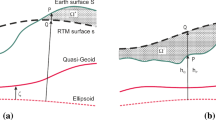Abstract
Forward gravity field modelling requires high accurate determination of the topographic potential on the surface of the Earth’s ellipsoid. Since the topography is recently known with high resolution, the determination of the harmonic analysis of the topographic ellipsoidal potential should be carried-out to an ultra-high degree. The paper presents a direct technique to determine the harmonic analysis of the ellipsoidal potential to an ultra-high degree. The detailed derivation of the developed expressions is given. The proposed technique can be used to compute the harmonic analysis of the topographic potential of the whole Earth or for a local/regional window. This has a great advantage when using the proposed technique for local/regional geoid determination within the window remove–restore technique (Abd-Elmotaal and Kühtreiber, Phys Chem Earth Part A 24(1):53–59, 1999, J Geod 77(1–2):77–85, 2003). The developed technique has been compared to existing global solutions for the ellipsoidal topographic potential and it shows quite good agreement. Local tests for the developed technique proved that it works very well.









Similar content being viewed by others
References
Abd-Elmotaal HA (1998) An alternative capable technique for the evaluation of geopotential from spherical harmonic expansions. Bollettino di geodesia e scienze affini 57(1):25–38
Abd-Elmotaal HA (2017) Gravimetric geoid for Egypt implementing Moho depths and optimal geoid fitting approach. Stud Geophys Geod 61:657–674. https://doi.org/10.1007/s11200-015-1258-2
Abd-Elmotaal HA, Kühtreiber N (1999) Improving the geoid accuracy by adapting the reference field. Phys Chem Earth Part A 24(1):53–59
Abd-Elmotaal HA, Kühtreiber N (2003) Geoid determination using adapted reference field, seismic Moho depths and variable density contrast. J Geod 77(1–2):77–85
Abd-Elmotaal HA, Kühtreiber N (2007) Comparison between window technique and modified Stokes’ kernel in geoid determination for Austria. Österr Z Vermess Geoinform 95(4):267–274
Abd-Elmotaal HA, Makhloof A, Abd-Elbaky M, Ashry M (2017) The African \(3^{\prime \prime } \times \,3^{\prime \prime }\) DTM and its validation. Int Assoc Geody Sympos 148:79–85. https://doi.org/10.1007/1345_2017_19
Abykosov O, Ince ES, Förste C, Flechtner F (2019) ROLI topographic gravity field model from four-layer earth decomposition. GFZ Data Serv. https://doi.org/10.5880/ICGEM.2019.011
Becker JJ, Sandwell DT, Smith WHF, Braud J, Binder B, Depner J, Fabre D, Factor J, Ingalls S, Kim SH, Ladner R, Marks K, Nelson S, Pharaoh A, Sharman G, Trimmer R, vonRosenburg J, Wallace G, Weatherall P (2003) Global bathymetry and elevation data at 30 arc seconds resolution: SRTM30_PLUS. Mar Geodesy 32(4):355–371
Claessens SJ, Hirt C (2013) Ellipsoidal topographic potential: new solutions for spectral forward gravity modeling of topography with respect to a reference ellipsoid. J Geophys Res Solid Earth 118:5991–6002. https://doi.org/10.1002/2013JB010457
Forsberg R (1984) A study of terrain reductions, density anomalies and geophysical inversion methods in gravity field modelling. Ohio State University, Department of Geodetic Science and Surveying, Rep 355
Grombein T, Luo X, Seitz K, Heck B (2014) A wavelet-based assessment of topographic–isostatic reductions for GOCE gravity gradients. Surv Geophys 35(4):959–982
Grombein T, Seitz K, Heck B (2016) The rock–water–ice topographic gravity field model RWI_TOPO_2015 and its comparison to a conventional rock-equivalent version. Surv Geophys 37:937–976. https://doi.org/10.1007/s10712-016-9376-0
Heiskanen WA, Moritz H (1967) Physical geodesy. Freeman, San Francisco
Hirt C, Kuhn M (2012) Evaluation of high-degree series expansions of the topographic potential to higher-order powers. J Geophys Res 117(B12):407. https://doi.org/10.1029/2012JB009492
Hirt C, Rexer M (2015) Earth 2014: 1 arc-min shape, topography, bedrock and ice-sheet models - available as gridded data and degree 10,800 spherical harmonics. Int J Appl Earth Obs Geoinf 39:103–112. https://doi.org/10.1016/j.jag.2015.03.001
Moritz H (2000) Geodetic reference system 1980. J Geodesy 74(1):128–133
Rapp RH (1982) A Fortran program for the computation of gravimetric quantities from high degree spherical harmonic expansions. Ohio State University, Department of Geodetic Science and Surveying Rep 334
Rummel R, Rapp R, Sünkel H, Tscherning C (1988) Comparisons of global topographic/isostatic models to the earth’s observed gravity field. Ohio State University, Department of Geodetic Science and Surveying, Rep 388
Torge W, Müller J (2012) Geodesy, 4th edn. Walter de Gruyter, Berlin
Tscherning CC, Rapp RH, Goad C (1983) A comparison of methods for computing gravimetric quantities from high degree spherical harmonic expansions. Manuscr Geod 8:249–272
Vaniček P, Krakiwsky E (1982) Geodesy: the concepts. The North-Holland Publishing Company, Amsterdam
Acknowledgements
The authors would like to thank the editor of this paper and two anonymous reviewers for their useful suggestions and critical comments.
Author information
Authors and Affiliations
Corresponding author
Additional information
Publisher's Note
Springer Nature remains neutral with regard to jurisdictional claims in published maps and institutional affiliations.
Rights and permissions
About this article
Cite this article
Abd-Elmotaal, H.A., Kühtreiber, N. Direct Harmonic Analysis for the Ellipsoidal Topographic Potential with Global and Local Validation. Surv Geophys 42, 159–176 (2021). https://doi.org/10.1007/s10712-020-09614-4
Received:
Accepted:
Published:
Issue Date:
DOI: https://doi.org/10.1007/s10712-020-09614-4




